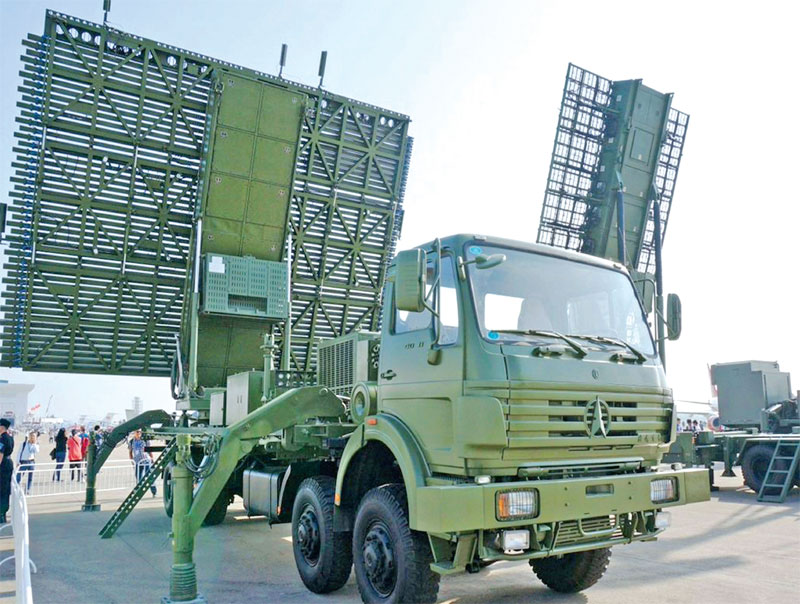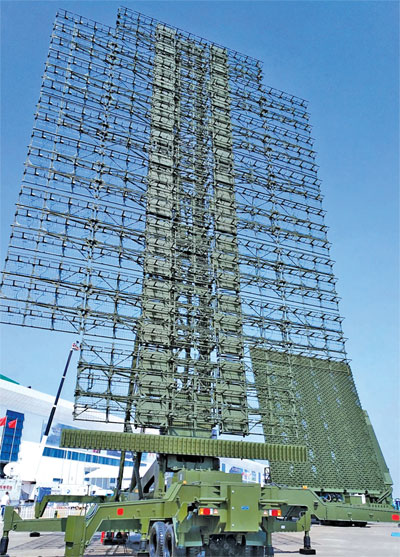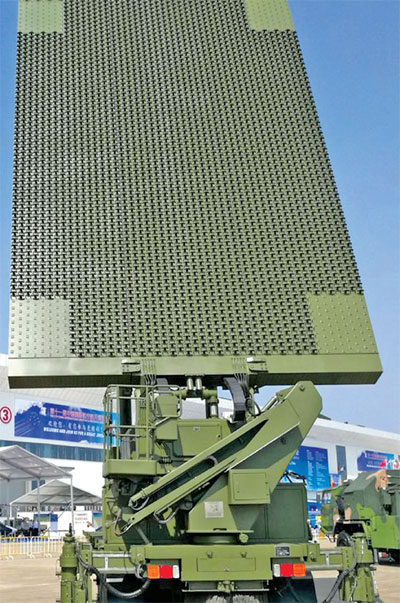China holds the 9th edition of international radar expo for current and future customers
Prasun K. Sengupta
The three-day 9th World Radar Expo that kicked off in Nanjing, East China’s Jiangsu Province, on April 22, was co-hosted by the China Radar Industry Association, the China Electronics Technology Group Co Ltd (CETC) and the China Electronics Information Industry Group Co Ltd (CEC).

This expo was held in the ancient city of Nanjing for two consecutive editions because the city was the birthplace of China’s radar-related research and development programmes since 1949. The state-owned No. 14 Research Institute of CETC has existed there for 72 years. More than 50 international delegates from over 30 countries participating in the China-led Belt and Road Initiative were present as invited guests at the expo.
At the expo site, CETC displayed two types of new-generation counter-stealth radars, namely the flagship YLC-8E UHF-band 3-D airspace surveillance radar and the SLC-7 L-band 3-D surveillance airspace radar. Also shown was the S-band YLC-48 portable multifunctional reconnaissance radar, which can be used for detecting and tracking both manned and unmanned aerial platforms cruising at low-level, as well as inbound mortar/artillery rounds. The cylindrical-shaped YLC-48 adopts the domestic pioneering circular digital phased-array systems architecture, weighs 90kg and is vehicle-mounted. The No. 14 Research Institute has also developed the AUDS high-mobility anti-drone system based on the YLC-48.
Also, on display was the YLC-18A L-band 3-D low-level gapfiller radar. On the other hand, the No. 38 Research Institute of the CETC exhibited the UHF-band JY-26 ‘Skywatch-U’ long-range 3-D counter-stealth radar, at the expo. It works on UHF-band and can conduct anti-aircraft and anti-missile missions. Operating in the 250-350MHz bandwidth, this radar features a digital active electronically scanned array (AESA) antenna developed by the state-owned East China Research Institute of Electronic Engineering (ECRIEE). The bubble surface of the radar looks similar to Lockheed Martin’s G-band (5.4GHz) Three Dimensional Expeditionary Long-Range Radar (3D-ELRR). The surface of both these radars is analogous to the bubble-wrap used to ship breakable items by mail. The bubbles on the radar antennae are transmit-receive modules (TRM), but the JY-26 has fewer TRMs then the 3D-ELRR.
Other radars exhibited at the expo included the JY-27A ‘Skywatch-V’ VHF-band radar, and the KLJ-7A, CETC’s first AESA multi-mode radar developed for combat aircraft, which is now being made available for export. Also shown was the YLC-2V ‘High Guard’ S-band passive electronically scanned array radar. CETC’s exhibits indicated a focus on combining active and passive detection systems, including the flight-line display of a large-area directional, wideband passive receiver system identified as YLC-20. It is used as an adjunct to the CETC-built DWL-002, which is a three-station passive coherent location (PCL) system, using time-difference-of-arrival processing to locate and track targets.
Also shown on a wall chart was the JY-50/REL-4 ‘passive radar’ from CEC, which operates in the VHF band. Previous PCL systems were designed to exploit active emissions from the target. However, by teaming PCL and other passive receivers with active radars, the defender creates bi-static and multi-static detection systems, which reduces the effectiveness of RCS-reduction measures that are primarily monostatic. For instance, highly swept leading edges of a combat aircraft are designed to deflect radar signals away from the source, but can create spikes detectable by multi-static systems.

One of the classic drawbacks of VHF is the slow scan-rate. With the JY-27A, electronic scanning is superimposed on mechanical scanning. The radar can scan a 120-degree sector mechanically, maintaining continuous track through all but the outer 15-degree sectors. Within the scan area, the scan is virtually instantaneous, allowing energy to be focused on any possible target. It retains the basic advantages of VHF: CETC claims that while the DF-15 tactical ballistic missile has a 0.002 square-metre radar cross-section (RCS) in X-band, this becomes 0.6 square metres in the VHF bandwidth. The principle behind the usage of VHF-band and UHF-band radars is the fusion of data from up to three radars to create a robust kill-chain. The VHF radar performs initial detection and cues the UHF radar, which in turn can cue the X-bandradars.
A ‘data fusion’ system provides accurate azimuth data and makes it possible for the three signals to be combined into a single target picture. The higher-frequency radars are more accurate than VHF, and can concentrate energy on a target to make successful detection and tracking more likely. Usage of ‘stop and stare’ modes, where the antenna rotation stops and the radar scans electronically over a 90-degree sector, results in four times as much energy being concentrated on target as continuous rotation and thus in turn increases the detection range by 40 per cent. China’s radar manufacturers like CETC and CEC have thus taken an approach similar to that of Russia’s radar developers.
CETC has also developed mast-mounted battlefield surveillance radars and SIGINT sensors, both of which are available as vehicle-mounted systems and were deployed in large numbers by the border defence regiments of China’s Peoples’ Liberation Army all along the Line of Actual Control in eastern Ladakh.

As far as export successes go, Venezuela remains the biggest customer of China-supplied radars. In August 2005, a contract was signed with CETC for the purchase of three JYL-1 S-band, 3-D long-range airspace surveillance radars. In 2006, CETC was awarded a new contract worth USD150 million for supplying an additional seven JYL-1 radars, three S-band JY-11B radars and a single HK-JM2 VHF long-range airspace surveillance radar.
Pakistan is the second largest customer for CETC to date, having imported two YLC-2A L-band medium-power radars (MPR) and one JY-27A for the Pakistan Air Force, SEMIC Type 825 fire-control radars for PG-99 Type 90 anti-aircraft cannons of the Pakistan Navy’s 21st Air Defence Battalion and four CS-RB1 HGR-106 MPRs for the Pakistan Navy, and is now eyeing the YLC-18A gapfiller radars for replacing the air force’s 68 existing 1980s vintage SIEMENS-built SILLACS L-Band MPDR-45 (with 45km-range), MPDR-60 (with 60km-range) and MPDR-90 (with 90km-range) low-level gapfiller radars. Myanmar too has procured three YLC-2A MPRs, while Sri Lanka’s air force operates a solitary YLC–18 L-band low-level gapfiller radar. The Bangladesh Army has to date procured two SLC-2 S-band weapon locating radars from CETC.

